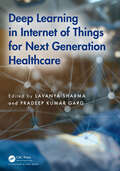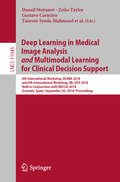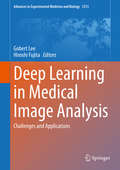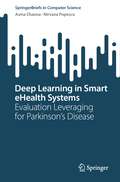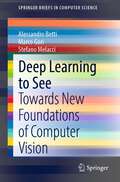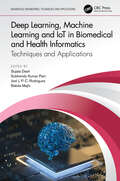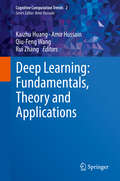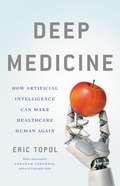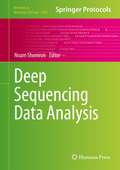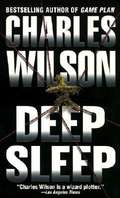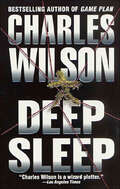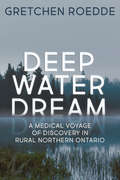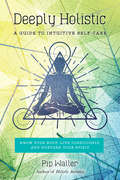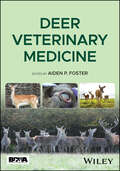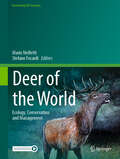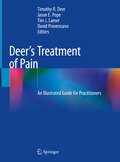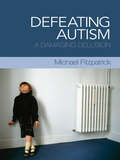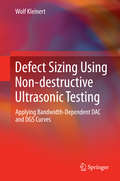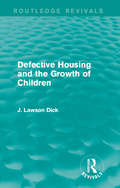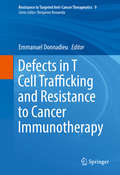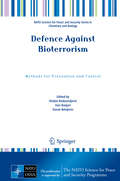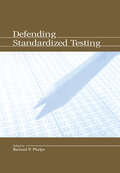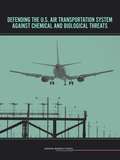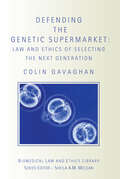- Table View
- List View
Deep Learning in Internet of Things for Next Generation Healthcare
by Lavanya Sharma Pradeep Kumar GargThis book presents the latest developments in deep learning-enabled healthcare tools and technologies and offers practical ideas for using the IoT with deep learning (motion-based object data) to deal with human dynamics and challenges including critical application domains, technologies, medical imaging, drug discovery, insurance fraud detection and solutions to handle relevant challenges. This book covers real-time healthcare applications, novel solutions, current open challenges, and the future of deep learning for next-generation healthcare. It includes detailed analysis of the utilization of the IoT with deep learning and its underlying technologies in critical application areas of emergency departments such as drug discovery, medical imaging, fraud detection, Alzheimer's disease, and genomes. Presents practical approaches of using the IoT with deep learning vision and how it deals with human dynamics Offers novel solution for medical imaging including skin lesion detection, cancer detection, enhancement techniques for MRI images, automated disease prediction, fraud detection, genomes, and many more Includes the latest technological advances in the IoT and deep learning with their implementations in healthcare Combines deep learning and analysis in the unified framework to understand both IoT and deep learning applications Covers the challenging issues related to data collection by sensors, detection and tracking of moving objects and solutions to handle relevant challenges Postgraduate students and researchers in the departments of computer science, working in the areas of the IoT, deep learning, machine learning, image processing, big data, cloud computing, and remote sensing will find this book useful.
Deep Learning in Medical Image Analysis and Multimodal Learning for Clinical Decision Support: 4th International Workshop, Dlmia 2018, And 8th International Workshop, Ml-cds 2018, Held In Conjunction With Miccai 2018, Granada, Spain, September 20, 2018. Proceedings (Lecture Notes in Computer Science #11045)
by Andrew Bradley João Manuel R. S. Tavares Gustavo Carneiro Vasileios Belagiannis Jacinto C. Nascimento Zhi Lu Lena Maier-Hein Tanveer Syeda-Mahmood Mehdi Moradi Hayit Greenspan Anant Madabhushi Danail Stoyanov Zeike Taylor Anne Martel Joao Paulo Papa Sailesh ConjetiThis book constitutes the refereed joint proceedings of the 4th International Workshop on Deep Learning in Medical Image Analysis, DLMIA 2018, and the 8th International Workshop on Multimodal Learning for Clinical Decision Support, ML-CDS 2018, held in conjunction with the 21st International Conference on Medical Imaging and Computer-Assisted Intervention, MICCAI 2018, in Granada, Spain, in September 2018. The 39 full papers presented at DLMIA 2018 and the 4 full papers presented at ML-CDS 2018 were carefully reviewed and selected from 85 submissions to DLMIA and 6 submissions to ML-CDS. The DLMIA papers focus on the design and use of deep learning methods in medical imaging. The ML-CDS papers discuss new techniques of multimodal mining/retrieval and their use in clinical decision support.
Deep Learning in Medical Image Analysis: Challenges and Applications (Advances in Experimental Medicine and Biology #1213)
by Hiroshi Fujita Gobert LeeThis book presents cutting-edge research and applications of deep learning in a broad range of medical imaging scenarios, such as computer-aided diagnosis, image segmentation, tissue recognition and classification, and other areas of medical and healthcare problems. Each of its chapters covers a topic in depth, ranging from medical image synthesis and techniques for muskuloskeletal analysis to diagnostic tools for breast lesions on digital mammograms and glaucoma on retinal fundus images. It also provides an overview of deep learning in medical image analysis and highlights issues and challenges encountered by researchers and clinicians, surveying and discussing practical approaches in general and in the context of specific problems. Academics, clinical and industry researchers, as well as young researchers and graduate students in medical imaging, computer-aided-diagnosis, biomedical engineering and computer vision will find this book a great reference and very useful learning resource.
Deep Learning in Smart eHealth Systems: Evaluation Leveraging for Parkinson’s Disease (SpringerBriefs in Computer Science)
by Asma Channa Nirvana PopescuOne of the main benefits of this book is that it presents a comprehensive and innovative eHealth framework that leverages deep learning and IoT wearable devices for the evaluation of Parkinson's disease patients. This framework offers a new way to assess and monitor patients' motor deficits in a personalized and automated way, improving the efficiency and accuracy of diagnosis and treatment.Compared to other books on eHealth and Parkinson's disease, this book offers a unique perspective and solution to the challenges facing patients and healthcare providers. It combines state-of-the-art technology, such as wearable devices and deep learning algorithms, with clinical expertise to develop a personalized and efficient evaluation framework for Parkinson's disease patients.This book provides a roadmap for the integration of cutting-edge technology into clinical practice, paving the way for more effective and patient-centered healthcare. To understand this book, readers should have a basic knowledge of eHealth, IoT, deep learning, and Parkinson's disease. However, the book provides clear explanations and examples to make the content accessible to a wider audience, including researchers, practitioners, and students interested in the intersection of technology and healthcare.
Deep Learning to See: Towards New Foundations of Computer Vision (SpringerBriefs in Computer Science)
by Marco Gori Alessandro Betti Stefano MelacciThe remarkable progress in computer vision over the last few years is, by and large, attributed to deep learning, fueled by the availability of huge sets of labeled data, and paired with the explosive growth of the GPU paradigm. While subscribing to this view, this work criticizes the supposed scientific progress in the field, and proposes the investigation of vision within the framework of information-based laws of nature. This work poses fundamental questions about vision that remain far from understood, leading the reader on a journey populated by novel challenges resonating with the foundations of machine learning. The central thesis proposed is that for a deeper understanding of visual computational processes, it is necessary to look beyond the applications of general purpose machine learning algorithms, and focus instead on appropriate learning theories that take into account the spatiotemporal nature of the visual signal.Serving to inspire and stimulate critical reflection and discussion, yet requiring no prior advanced technical knowledge, the text can naturally be paired with classic textbooks on computer vision to better frame the current state of the art, open problems, and novel potential solutions. As such, it will be of great benefit to graduate and advanced undergraduate students in computer science, computational neuroscience, physics, and other related disciplines.
Deep Learning, Machine Learning and IoT in Biomedical and Health Informatics: Techniques and Applications (Biomedical Engineering)
by Sujata Dash Joel J. P. C. Rodrigues Subhendu Kumar Pani Babita MajhiBiomedical and Health Informatics is an important field that brings tremendous opportunities and helps address challenges due to an abundance of available biomedical data. This book examines and demonstrates state-of-the-art approaches for IoT and Machine Learning based biomedical and health related applications. This book aims to provide computational methods for accumulating, updating and changing knowledge in intelligent systems and particularly learning mechanisms that help us to induce knowledge from the data. It is helpful in cases where direct algorithmic solutions are unavailable, there is lack of formal models, or the knowledge about the application domain is inadequately defined. In the future IoT has the impending capability to change the way we work and live. These computing methods also play a significant role in design and optimization in diverse engineering disciplines. With the influence and the development of the IoT concept, the need for AI (artificial intelligence) techniques has become more significant than ever. The aim of these techniques is to accept imprecision, uncertainties and approximations to get a rapid solution. However, recent advancements in representation of intelligent IoTsystems generate a more intelligent and robust system providing a human interpretable, low-cost, and approximate solution. Intelligent IoT systems have demonstrated great performance to a variety of areas including big data analytics, time series, biomedical and health informatics. This book will be very beneficial for the new researchers and practitioners working in the biomedical and healthcare fields to quickly know the best performing methods. It will also be suitable for a wide range of readers who may not be scientists but who are also interested in the practice of such areas as medical image retrieval, brain image segmentation, among others. • Discusses deep learning, IoT, machine learning, and biomedical data analysis with broad coverage of basic scientific applications • Presents deep learning and the tremendous improvement in accuracy, robustness, and cross- language generalizability it has over conventional approaches • Discusses various techniques of IoT systems for healthcare data analytics • Provides state-of-the-art methods of deep learning, machine learning and IoT in biomedical and health informatics • Focuses more on the application of algorithms in various real life biomedical and engineering problems
Deep Learning: Fundamentals, Theory and Applications (Cognitive Computation Trends #2)
by Amir Hussain Rui Zhang Kaizhu Huang Qiu-Feng WangThe purpose of this edited volume is to provide a comprehensive overview on the fundamentals of deep learning, introduce the widely-used learning architectures and algorithms, present its latest theoretical progress, discuss the most popular deep learning platforms and data sets, and describe how many deep learning methodologies have brought great breakthroughs in various applications of text, image, video, speech and audio processing. Deep learning (DL) has been widely considered as the next generation of machine learning methodology. DL attracts much attention and also achieves great success in pattern recognition, computer vision, data mining, and knowledge discovery due to its great capability in learning high-level abstract features from vast amount of data. This new book will not only attempt to provide a general roadmap or guidance to the current deep learning methodologies, but also present the challenges and envision new perspectives which may lead to further breakthroughs in this field. This book will serve as a useful reference for senior (undergraduate or graduate) students in computer science, statistics, electrical engineering, as well as others interested in studying or exploring the potential of exploiting deep learning algorithms. It will also be of special interest to researchers in the area of AI, pattern recognition, machine learning and related areas, alongside engineers interested in applying deep learning models in existing or new practical applications.
Deep Medicine: How Artificial Intelligence Can Make Healthcare Human Again
by Eric TopolOne of America's top doctors reveals how AI will empower physicians and revolutionize patient care Medicine has become inhuman, to disastrous effect. The doctor-patient relationship--the heart of medicine--is broken: doctors are too distracted and overwhelmed to truly connect with their patients, and medical errors and misdiagnoses abound. In Deep Medicine, leading physician Eric Topol reveals how artificial intelligence can help. AI has the potential to transform everything doctors do, from notetaking and medical scans to diagnosis and treatment, greatly cutting down the cost of medicine and reducing human mortality. By freeing physicians from the tasks that interfere with human connection, AI will create space for the real healing that takes place between a doctor who can listen and a patient who needs to be heard.Innovative, provocative, and hopeful, Deep Medicine shows us how the awesome power of AI can make medicine better, for all the humans involved.
Deep Sequencing Data Analysis
by Noam ShomronThe new genetic revolution is fuelled by Deep Sequencing (or Next Generation Sequencing) apparatuses which, in essence, read billions of nucleotides per reaction. Effectively, when carefully planned, any experimental question which can be translated into reading nucleic acids can be applied.In Deep Sequencing Data Analysis, expert researchers in the field detail methods which are now commonly used to study the multi-facet deep sequencing data field. These included techniques for compressing of data generated, Chromatin Immunoprecipitation (ChIP-seq), and various approaches for the identification of sequence variants. Written in the highly successful Methods in Molecular Biology series format, chapters include introductions to their respective topics, lists of necessary materials and reagents, step-by-step, readily reproducible protocols, and key tips on troubleshooting and avoiding known pitfalls. Authoritative and practical, Deep Sequencing Data Analysis seeks to aid scientists in the further understanding key data analysis procedures for deep sequencing data interpretation.
Deep Sleep
by Charles WilsonThe South Louisiana Sleep Disorders Institute promises to let you live out your dreams in your sleep--to experience them so strongly that afterwards you won't be able to tell the difference between them and real memories. The Institute Director claims to use these lucid dreams only as therapy for her clients. But when one of the clinic's clients and two of its neighbors are murdered, Detective Mark French finds that the institute also has more sinister purposes.
Deep Sleep
by Charles WilsonThe South Louisiana Sleep Disorders Institute promises to let you live out your dreams in your sleep—to experience them so strongly that afterwards you won't be able to tell the difference between them and real memories. The Institute Director claims to use these lucid dreams only as therapy for her clients. But when one of the clinic's clients and two of its neighbors are murdered, Detective Mark French finds that the institute also has more sinister purposes.
Deep Water Dream: A Medical Voyage of Discovery in Rural Northern Ontario
by Gretchen RoeddeA hopeful memoir that shares the author’s voyage of discovery as a mother, wife, and physician in underserved communities in northern Ontario. In underserved areas of Canada, the communities themselves can be one of the strongest parts of the health care team. Dr. Gretchen Roedde shows how local communities play a major role in responding to illness, birth, and death, making each more meaningful and bearable. In Deep Water Dream, Roedde recounts stories from her long career — from working with a Cree community in developing a medical dictionary in their own language, to training community-based health workers, to delivering Amish babies in her own home. Roedde redraws the boundaries between physician and community, strengthening the capacity to care for those close by,and offers a hopeful and powerful example to the rest of the world.
Deeply Holistic: A Guide to Intuitive Self-Care--Know Your Body, Live Consciously, and NurtureYour Spirit
by Pip WallerThis user-friendly guide gives straightforward and practical advice to anyone who wants a holistic approach to taking care of themselves naturally. Following the traditional framework of an anatomy book that explains each body system chapter-by-chapter, Pip Waller—an experienced practitioner and teacher—provides fundamental information and tips about exercise, diet, supplements, understanding and caring for your emotional and mental health, naturopathic principles from various traditions, and simple yet effective ways of working with spiritual energy. Based on the premise that an underlying vital force—which needs to be in balance for health to be fully present—animates all life, this book is designed to support and promote our inherent tendency toward wholeness and equilibrium. Each chapter includes fun recipes to enhance health and well-being.
Deer Veterinary Medicine
by Aiden P. FosterA guide to the care and treatment of deer for veterinary professionals Deer Veterinary Medicine is an essential reference for veterinary professionals preparing for deer encounters. Rooted in extensive field experience, the contributions from a range of authors provide details of common conditions across multiple deer species and the knowledge required by the veterinary professionals who deal with them. The book considers the different contexts where deer are encountered, including wild populations, and deer held in captivity (as farm, park and zoo collections). The chapters topics range from handling and sedating deer through to nutrition and postmortem examination and pathology. They cover key body systems including the gut, nervous, ocular and respiratory systems, and the skin. Deer Veterinary Medicine readers will also find: Detailed consideration of the use of sedation in deer, providing analgesia and methods of euthanasia.Coverage of species including red, roe, fallow, water deer, Reeves’ muntjac, reindeer and white-tailed deer.Coverage of veterinary interventions for reproductive purposes.Detailed consideration of the management of parasitic diseases.Detailed consideration of notifiable (including TB and CWD) and zoonotic diseases (including E. coli and cryptosporidiosis).A detailed drug formulary including, where available, evidence from published studies. Edited by the past president of the British Deer Veterinary Association (BDVA) this book is a fitting successor to Management and Diseases of Deer: A Handbook for Veterinary Surgeons, last published in 1994 by the Veterinary Deer Society (now the BDVA). Synthesizing key contributions by a range of experts from Europe and the US, the new Deer Veterinary Medicine is ideal for veterinarians, veterinary surgeons and veterinary students, as well as readers interested in the management of captive and wild deer.
Deer of the World: Ecology, Conservation and Management (Fascinating Life Sciences)
by Mario Melletti Stefano FocardiThis book is the first comprehensive reference work ever published on the systematics, ecology, conservation status, and management of all the world's deer species. Covering all 53 deer species worldwide, this volume brings together the contributions of 160 international deer experts and provides: A comprehensive overview of the current state of knowledge on the evolution, phylogeny, taxonomy, and systematics of deer An in-depth insight into the ecology and conservation status of each species, with detailed accounts A series of case studies on conservation, management, hunting, farming, disease ecology, and the impact of deer on forest ecosystems. This beautifully illustrated book is an invaluable resource for researchers, wildlife managers, and students of conservation biology, ecology, and management, as well as the interested layperson. It reveals the fascinating story of deer evolution, the long history of human interactions with deer, and the major threats to this charismatic species group.
Deer's Treatment of Pain: An Illustrated Guide for Practitioners
by Jason E. Pope Timothy R. Deer Tim J. Lamer David ProvenzanoDesigned and written by a team of clinically established academics, this is a unique book that is an excellent manual for physicians practicing pain medicine or treating pain in neurosurgery, orthopedic, neurology, or family practice clinics. As a practical resource, this book is written to be more accessible to the reader and is designed to be more clinically-focused and useful in day-to-day practice. This 102 chapter volume is divided into seven separate sections: Anatomy and Physiology of Pain, Psychology of Pain, Pharmacological Treatment of Pain, Interventional Treatment of Pain, Adjuvant Therapies for Pain and Suggested Reading. The calculated organization of this book is supplemented by key photos, drawings and a self-assessment of four key questions at the end of each chapter -- thus making it an indispensable, pragmatic resource that will benefit anyone working in the pain management field. Deer's Treatment of Pain: An Illustrated Guide for Practitioners contains pearls for improving knowledge and improving one’s practice as a physician.
Defeating Autism: A Damaging Delusion
by Michael FitzpatrickAutism: disease, disorder or difference? What causes autism – genes or environment? Can biomedical treatments cure autism, and are they safe? An increased public awareness of autism has resulted in a rising trend of diagnoses, creating the impression of an ‘epidemic’. Many parents of children newly diagnosed with autism have been impressed by plausible theories blaming vaccines and other environmental causes. Many have also been captivated by claims that ‘biomedical’ treatments – including special diets and supplements, detoxification and medications – can achieve dramatic results. In Defeating Autism, Michael Fitzpatrick, a family doctor and father of a son with autism, questions the scientific basis of environmental explanations of autism and exposes the incoherence of unorthodox ‘biomedical’ theories and therapies. This book reveals that these therapies are far from pioneering interventions and they remain unsubstantiated by scientific authorities. Campaigns promising to ‘defeat or cure autism now’ have attracted much support among parents struggling with their difficult children. But the crusade against autism risks dehumanising and stigmatising those who are identified as autistic and their families. This compelling book is essential reading for students and professionals working in the field of autism, as well as academics concerned with the public understanding of science and the treatment of scientific and medical controversies in the media.
Defect Sizing Using Non-destructive Ultrasonic Testing
by Wolf KleinertThis book presents a precise approach for defect sizing using ultrasonics. It describes an alternative to the current European and American standards by neglecting their limitations. The approach presented here is not only valid for conventional angle beam probes, but also for phased array angle beam probes. It introduces an improved method which provides a significant productivity gain and calculates curves with high accuracy. Its content is of interest to all those working with distance gain size (DGS) methods or are using distance amplitude correction (DAC) curves.
Defective Housing and the Growth of Children (Routledge Revivals)
by J. Lawson DickAfter World War I, housing was one of many pressing issues facing the country with multiple families often crowded in together in inadequate housing. This had a dramatic impact on health with increasing problems such as tuberculosis and malnutrition. Originally published in 1919, this study aimed to identify the ways in which defective housing impacted on health in the family with a particular focus on rickets in children in the East end of London and the developmental issues resulting from it. This title will be of interest to students of Medical History and Health and Social Care.
Defects in T Cell Trafficking and Resistance to Cancer Immunotherapy
by Emmanuel DonnadieuThis volume focuses on the recent advances in understanding T cells are key players in antitumor immune responses and T cell-based immunotherapy is starting to transform the treatment of advanced cancers. However, despite recent successes, many patients with cancer fail to respond to these treatments. Defective migration of T cells into and within tumors is considered as an important resistance mechanism to cancer immunotherapy. The volume includes three sections. The first section covers general knowledge about T cell trafficking during a normal immune response but also during tumor development. The second section provides an in-depth description of the different obstacles that prevent T cells from migrating and contacting tumor cells. The third section explores therapeutic strategies to improve trafficking of T cells into tumors and, thus, to enhance the effectiveness of cancer immunotherapy.
Defence Against Bioterrorism: Methods For Prevention And Control (NATO Science For Peace And Security Series B: Physics and Biophysics)
by Vladan Radosavljevic Goran Belojevic Ines BanjariThis volume is based on a multidisciplinary approach towards biological and chemical threats that can, and have been previously used in bioterrorism attacks around the globe. Current knowledge and evidence-based principles from the fields of synthetic biology, microbiology, plant biology, chemistry, food science, forensics, tactics, infective medicine, psychology and others are compiled to address numerous aspects and the complexity of bioterrorism attacks. The main focus is on biological threats, especially in the context of synthetic biology and its emerging findings that can be observed as possible threat and tool. The book examines microorganisms and their possible use in forensics, i.e. as possible detection tool that could enable fast and precise detection of possible treats. A number of plant derived components are also discussed as possible agents in bioterrorism attacks, and in relation to infectious disease pathology. Another integral part is food safety, especially in terms of large food supply chains, like airline caterings, institutionalized kitchens etc. Food can be observed as a possible mean of delivery of various agents (biological and chemical) for bioterrorism attacks. Steps on how to recognize specific critical points in a food supply chain, along with proposed corrective activities are discussed.Examples from around the globe, along with the methodological approach on how to differentiate bioterrorism attacks from other epidemics are provided. However, epidemics are also discussed in the context of migrations, with the special emphasis on the current refugee migrations that affect not only Europe, but also the United States. The book will be of interest to experts from various fields of science as well as professionals working in the field. The book encompasses examples and tools developed for easier, more specific, and faster detection of possible bioterrorism treats, along with proposed actions for some aspects of a bioterrorism attack.
Defending Standardized Testing
by Richard PhelpsThe education reform movement of the past two decades has focused on raising academic standards. Some standards advocates attach a testing mechanism to gauge the extent to which high standards are actually accomplished, whereas some critics accuse the push for standards and testing of impeding reform and perpetuating inequality. At the same time, the testing profession has produced advances in the format, accuracy, dependability, and utility of tests. Never before has obtaining such an abundance of accurate and useful information about student learning been possible. Meanwhile, the American public remains steadfast in support of testing to measure student performance and monitor the performance of educational systems.Many educational testing experts who acknowledge the benefits of testing also believe that those benefits have been insufficiently articulated. Although much has been written on standardized testing policy, most of the material has been written by opponents. The contributing authors of this volume are both accomplished researchers and practitioners who are respected and admired worldwide. They bring to the project an abundance of experience working with standardized tests.The goal of Defending Standardized Testing is to:*describe current standardized testing policies and strategies;*explain many of the common criticisms of standardized testing;*document the public support for, and the realized benefits of, standardized testing;*acknowledge the limitations of, and suggest improvements to, testing practices;*provide guidance for structuring and administering large-scale testing programs in light of public preferences and the "No Child Left Behind Act" requirements; and*present a defense of standardized testing and a vision for its future.Defending Standardized Testing minimizes the use of technical jargon so as to appeal to all who have a stake in American educational reform.
Defending The U.s. Air Transportation System Against Chemical And Biological Threats
by National Research Council of the National AcademiesHistorically, most terrorist attacks on civilian targets have involved the use of firearms or explosives, and current defensive strategies are aimed at preventing attacks perpetrated by such means. However, the use of the nerve agent sarin in 1995 to attack the Tokyo subway system, the use of the U.S. mail in 2001 to distribute letters containing anthrax spores, and the discovery in 2004 of the biological toxin ricin in U.S. Senate Office Buildings in Washington, D.C., demonstrate that chemical and biological agents have been added to terrorists' arsenals. Attacks involving chemical/biological agents are of great concern, not only because of the potential for mass casualties but also because there is no strategy or technology fielded today that can respond adequately to this threat. As the United States and other countries reassess the security measures they have in place to prevent or defend against such attacks, the risks to the air transportation system as a primary target become clear. Defending the U.S. Air Transportation System Against Chemical and Biological Threats is an exploration of defensive strategies that could be used to protect air transportation spaces (specifically, airport terminals and aircraft) against attack with chemical or biological agents and makes recommendations with respect to the role of TSA in implementing these strategies.
Defending the Constitution behind Enemy Lines: A Story of Hope for Those Who Love Liberty (Children’s Health Defense)
by Robert A. Green Jr.The story of a silenced minority who put their constitutional oaths before all else to keep our Founding Fathers' great gift of liberty alive. Defending the Constitution Behind Enemy Lines is an explosive, tell-all book, detailing the military COVID-19 vaccine mandate, and the resistance to that mandate by service members who could not, in good conscience, go along. As an actively serving Navy Commander, Robert A. Green Jr. removes the veil of military secrecy and complexity to shed light on the related unlawfulness and the official cover-up being committed by certain DoD leaders. His deep dive into the current crisis details the harms perpetrated against service members and their families as well as the destruction of military readiness that resulted. Standing upon his First Amendment rights, the first-time author analyzes the current crisis in light of the challenges faced by our Founding Fathers. His message to the American people is clear: The crisis our military is facing will only be solved by following in the footsteps of our Founding Fathers and returning to an adherence to the Constitution that our forebears sacrificed everything to leave us.
Defending the Genetic Supermarket: The Law and Ethics of Selecting the Next Generation (Biomedical Law and Ethics Library)
by Colin GavaghanThe controversial topic of the technology of Pre-implantation Genetic Diagnosis, and the muddled approach to this subject adopted by the UK Parliament, is explored in detail in this volume. The author takes the viewpoint that the HFEA has taken insufficient notice to date of certain core ethical principles and makes the case for a much more ethically consistent and humane system than has been managed so far. Arguing that many of the fears and objections levied against Robert Nozick’s notion of the ‘Genetic Supermarket’ by disability activists, christian bioethicists and radical feminists, amongst others, are internally inconsistent, philosophically unsound or merely highly improbable, the author considers a number of individual policy decisions of the HFEA and addresses such questions as: Can a case be made out for state involvement in such decisions? Who stands to be harmed by a supermarket model? Are any ethical principles or societal interests threatened by it? This book is an essential resource for law students of all levels and professionals working within or interested in medical and healthcare law and medical genetics.
